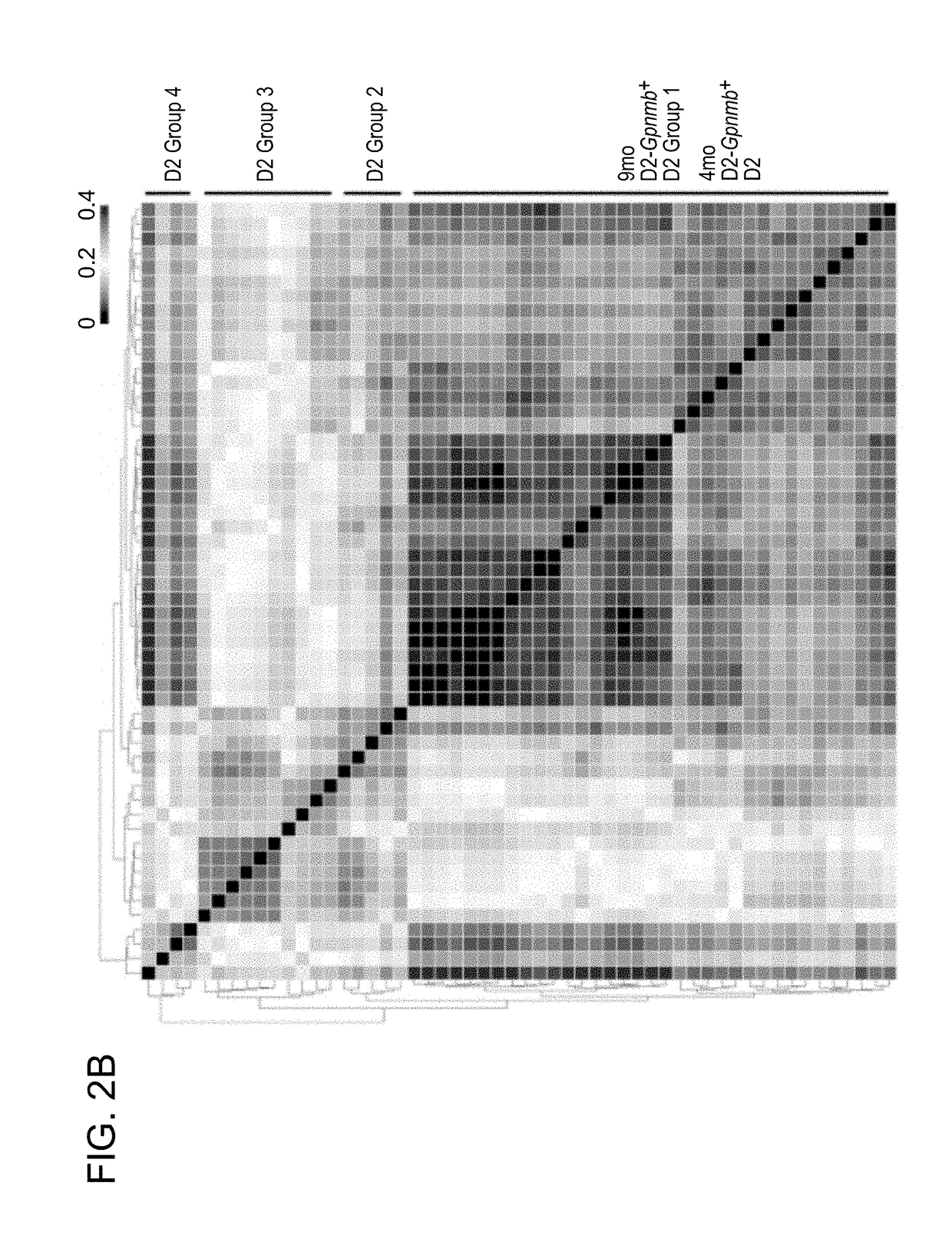Treatment and prevention of ocular neurodegenerative disorder
a neurodegenerative disorder and ocular neurodegeneration technology, applied in the direction of transferases, peptide/protein ingredients, drug compositions, etc., can solve the problem of no effective treatment or preventive measures targeting ocular neurodegeneration
- Summary
- Abstract
- Description
- Claims
- Application Information
AI Technical Summary
Benefits of technology
Problems solved by technology
Method used
Image
Examples
example 1
Identification of Glaucoma Susceptible Genes / Pathways
[0265](A) Selection of Mouse Model Mimicking Neurodegeneration in Humans
[0266]We chose the DBA / 2J D2 (D2) mouse model to examine the pathogenesis of neurodegeneration in humans. The D2 mouse is a widely used model of glaucoma, which recapitulates the hallmark features of human glaucoma. In D2 mice mutant alleles of two genes (GpnmbR250X, Tyrp1b) cause a progressive iris disease. This iris disease has two main components: and iris stromal atrophy (highly resembles essential iris atrophy in humans) and iris pigment dispersion phenotypes (highly resemble pigment dispersion syndrome in humans). Both essential iris atrophy and pigment dispersion syndrome induce IOP elevation and glaucoma in humans. Iris disease in D2 eyes results in age-related elevated intraocular pressure (IOP) in the majority of eyes by 8-9 months of age. Optic nerve degeneration is almost complete by 12 months of age (typically >70% nerves have severe damage).
[0267...
example 2
Metabolic Profiling
[0299]To determine whether mitochondrial dysfunction / energy crisis was present in D2 mice (as compared to the control D2-Gpnmb+ mice), during the pre- and the earliest stages of disease (i.e., at 4 months (pre-glaucoma), at 9 months of age when high IOP is present without any neurodegeneration, and at 12 months when neurodegeneration is present / severe in the majority of eyes), we performed metabolomic profiling of neural retinas.
[0300]We performed additional metabolic profiling of neural retinas from 4-, 9-, and 12-month D2 and D2-Gpnmb+ eyes. Metabolic profiling was performed using targeted assays following the manufacturers recommendations. The following metabolites were profiled: NAD+ / NADH (i.e. total NAD, NAD(t)), GSH / GSSG (i.e. total glutathione, glutathione(t)), and pyruvate. There were significant age-related decreases in all profiled metabolites. These metabolic profile changes occur prior to any detectable neurodegenerative phenotype and also occur in age...
example 3
NAM Protects Neuronal Cell Loss in Axotomy Culture
[0312]In this series of study, we examined if increasing the NAD levels can protect insulted eyes from neurodegenerative changes. Axotomy (i.e. the severing of the axon) mimics the acute severe insults seen in some glaucoma, and is an important model to test these more severe insults.
[0313]The study is based on the hypothesis that by decreasing the probability of metabolic / energetic failure, it would render the RGCs more resilient to the external stresses.
[0314]A plethora of drugs with actions at the mitochondria were tested in axotomy culture, in order to identify drug candidates that potentially antagonize the mitochondrial dysfunction / energy crisis observed in the D2 mice. The screen identified nicotinamide (NAM) as giving the most robust protection against nuclear shrinkage, a hallmark feature of nuclear remodeling pre-apoptosis. FIGS. 22A and 22B.
[0315]The above in vitro finding is consistent that the in vivo results in Example ...
PUM
| Property | Measurement | Unit |
|---|---|---|
| Pressure | aaaaa | aaaaa |
| Therapeutic | aaaaa | aaaaa |
Abstract
Description
Claims
Application Information
 Login to View More
Login to View More - R&D
- Intellectual Property
- Life Sciences
- Materials
- Tech Scout
- Unparalleled Data Quality
- Higher Quality Content
- 60% Fewer Hallucinations
Browse by: Latest US Patents, China's latest patents, Technical Efficacy Thesaurus, Application Domain, Technology Topic, Popular Technical Reports.
© 2025 PatSnap. All rights reserved.Legal|Privacy policy|Modern Slavery Act Transparency Statement|Sitemap|About US| Contact US: help@patsnap.com



